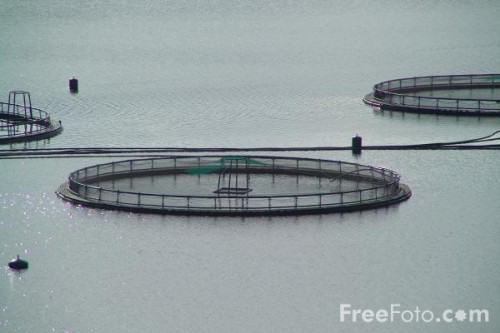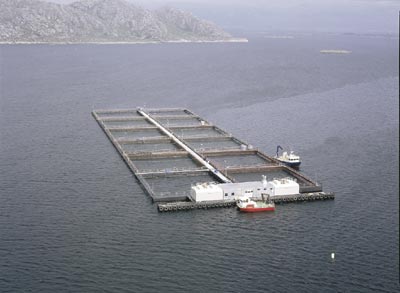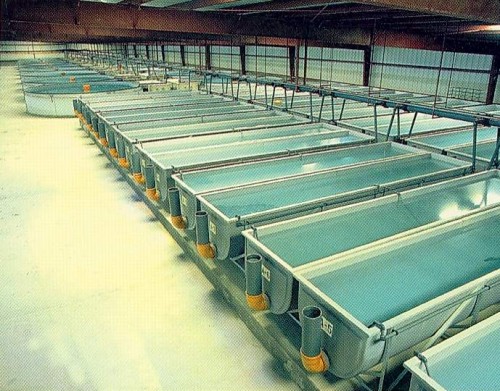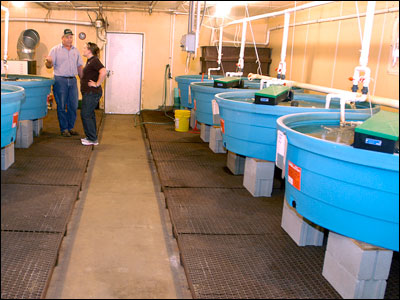Nearly half of the seafood we eat today is farmed. And while aquaculture is often equated with pollution, habitat degradation, and health risks, this explosive growth in fish farming may in fact be the most hopeful trend in the world’s increasingly troubled food system, according to a new report by Worldwatch Institute.
In Farming Fish for the Future, Senior Researcher Brian Halweil illustrates how, if properly guided, fish farming can not only help feed an expanding global population, but also play a role in healing marine ecosystems battered by overfishing.
“In a world where fresh water and grain supplies are increasingly scarce, raising seafood like oysters, clams, catfish, and tilapia is many times more efficient than factory-farmed chicken or beef,†says Halweil. “Farmed fish can be a critical way to add to the global diet to hedge against potential crop losses or shortages in the supply of meat.â€
“But not all fish farming is created equal,†Halweil notes. Carnivorous species like salmon and shrimp, while increasingly popular, consume several times their weight in fish feed—derived from other, typically smaller, fish—as they provide in edible seafood. “It generally requires 20 kilograms of feed to produce just 1 kilogram of tuna,†Halweil says. “So even as we depend more on farmed fish, a growing scarcity of fish feed may jeopardize future expansion of the industry.â€
Poorly run fish farms can generate coastal pollution in the form of excess feed and manure, and escaped fish and disease originating on farms can devastate wild fisheries. For example, a fish farm with 200,000 salmon releases nutrients and fecal matter roughly equivalent to the raw sewage generated by 20,000 to 60,000 people. Scotland’s salmon aquaculture industry is estimated to produce the same amount of nitrogen waste as the untreated sewage of 3.2 million people—just over half the country’s population.
Cramped facilities can also create ill health for fish, costing producers millions of dollars in disease prevention and foregone revenues. In recent years, shrimp farmers in China have lost $120 million to bacterial fish diseases and $420 million to shrimp diseases.
Fish farming has expanded to meet the soaring global demand for seafood. On average, each person on the planet is eating four times as much seafood as was consumed in 1950. The average per-capita consumption of farmed seafood has increased nearly 1,000 percent since 1970, in contrast to per-capita meat consumption, which grew just 60 percent.
In 2006, fish farmers raised nearly 70 million tons of seafood worth more than $80 billion—nearly double the volume of a decade earlier. Experts predict that farmed seafood will grow an additional 70 percent by 2030.
How can fish farming be made more sustainable? Innovative industry practices are key, but a shift toward sustainable fish farming will also require a fundamental change in public attitudes. This includes a willingness to prioritize fish that are lower on the food chain, such as shellfish and tilapia. But can consumers today be mobilized to shift the aquaculture industry in the same way they pressured tuna fleets to adopt more dolphin-friendly practices in the 1980s?
The need for more sustainable fish farming is critical, according to the report. Farmed seafood provides 42 percent of the world’s seafood supply, and is on target to exceed half in the next decade, yet there are no widely accepted standards for what constitutes “good†fish farming. By comparison, the organic food industry has strong international and national standards, even though it constitutes just 3 to 5 percent of the world’s food supply.
This points to a greater role for aquaculture certification and standards in the coming years, Halweil says. Efforts currently under way seek to model the effective labeling systems that exist in other areas of agriculture, such as for wild-caught fish, heritage breeds of livestock, and organic and local foods.
“The last wild ingredient in our diet is no longer completely wild,†says Halweil. “This doesn’t have to be a permanent situation, since wild fish stocks can recover. But as more coastal ecosystems are transformed into sites for fish pens, cages, and cultured seaweeds, fish farmers and the food industry will need to make ecological restoration as much a goal as meeting the growing demand for seafood.â€
Ecological Aquaculture
Ecological aquaculture, or “integrated multitrophic aquaculture,†involves designing farms to function more like healthy aquatic ecosystems. Generally, fish farms produce waste and pollute surrounding waters because of the high concentration and limited mobility of the fish. These factors also leave the fish more susceptible to disease. However, farms that integrate complementary species can greatly reduce pollution and disease levels. Cooke Aquaculture’s salmon farm in Back Bay, Canada, takes advantage of a natural ecosystem cleansing service provided by blue mussels and kelp. The shellfish filter excess waste from the fish cages, while the seaweed thrives on dissolved nutrients in the water.
Farming in the Warehouse
At the Center for Marine Biotechnology in Baltimore, Maryland, researchers are using city-supplied water and a complex filtration system to raise a few hundred fish completely indoors. Raising fish in a closed pen, either in a warehouse or floating on the ocean, avoids the common pitfalls of modern fish farming: net pens pollute coastal environments with waste and antibiotics, fish escapes threaten the diversity of wild populations, and diseases can spread easily. The Center’s operation is the first indoor marine aquaculture system that can re-circulate nearly all of its water and expel zero waste.
Cleaning Wastewater
If managed correctly, fish farms can go beyond addressing the problems caused by the industry itself and provide a net positive impact on the environment. Traditional ponds outside of Calcutta, India, called bheris, produce some 13,000 tons of fish a year for the city’s 12 million inhabitants, and serve as critical bird habitat. But the bigger environmental service they provide is that the fish feed on the 600 million liters of raw sewage that spews from Calcutta daily, turning a health risk into a key urban crop.
Restoring Habitats
Fish farming can help to restore degraded coral reefs and wetlands. The metal cages that hold farmed shellfish often function as artificial reefs around which striped bass, shad, and other marine species congregate. In the Caribbean, the Caicos Conch Farm raises King conch not just to sell to restaurants around the world, but to help re-seed coral reefs with this keystone species.
Eating Local Seafood
People who eat from their local waters have a natural reason to be concerned about what goes into them. The Southold Program in Aquaculture Training (SPAT) on Long Island, New York, helps volunteers raise baby shellfish in floating cages to restore the local scallop economy. Participants receive training in algae growth, marine ecology, and shellfish dynamics, and also get to eat half their harvest of fresh, mature shellfish. In turn, they report changing their daily habits that affect water quality, such as shunning chemical fertilizers, upgrading home septic systems, and using nontoxic paint on their boats.
Eating Little Fish to Save Big Ones
In Peru, massive schools of the tiny Peruvian anchovy are netted each year. Although the fish is chock-full of the same beneficial fatty acids that have made tuna, salmon, and other big fish famous for warding off heart disease and boosting brain development, nearly all of the anchovy catch is turned into fishmeal and fish oil, used to fatten pigs and chickens on factory farms worldwide. To address this problem, students at the University of Lima have launched a campaign to change the image of the anchoveta from something that only poor people eat into a tasty dish for well-heeled sophisticates.



